I have used Y-STR testing to confirm that my immigrant ancestor was Robert Thompson who died 1697 in St. Mary's County, Maryland. I used my list of Y-DNA matches at Family Tree DNA and the results in the Thompson surname project to do this.
You can read the story in Breaking through brick walls with Y-DNA. It was an amazing discovery that could not have been done without DNA.
Now I need to expand my search to find others who might be more distantly related and who can shed clues to the European origins of Robert Thompson. Some of these people will not share my surname.
The benefits of a haplogroup project
Now I need to expand my search to find others who might be more distantly related and who can shed clues to the European origins of Robert Thompson. Some of these people will not share my surname.
So I needed to conduct some SNP testing and join a haplogroup project.
This story assumes that you have read my previous blog post about STRs, SNPs, SNP testing, haplogroups, haplotrees, and the Big Y test. If you haven't read it, please do so now so that the following procedure will make sense. The page will open in a new tab so you won't lose your place here. See Y-DNA STRs, SNPs and haplogroups. You won't regret it.
I joined the R-FGC11134 haplogroup project to trace my line further, and so did one of my Thompson matches.
I joined the R-FGC11134 haplogroup project to trace my line further, and so did one of my Thompson matches.
In the image below, our test results are grouped with a man named Cairns.
Notice that a man named Thomson is placed with Edgecombes, and the two Thompsons are placed with Cairns.
 |
| Haplogroup Project |
Although they are showing different haplogroups because of each man's level of SNP testing, all of these men have the SNP FGC11134, and you might think that Thomson and Thompson should be placed together. Is this grouping correct?
I examined the STR patterns, and even though Cairns does not appear on my list of STR matches because he is not related closely enough to be considered a match by Family Tree DNA, it looks as though we might have shared a common ancestor sometime in the past.
Up next: We submitted our results to YFull.com. See What are the Benefits of YFull?
See the new changes to Big Y results and what they can reveal: Evaluating new Big Y changes
And the best part: What did the Thompson Big Y reveal? See The Big Y could be the best DNA test ever!
I examined the STR patterns, and even though Cairns does not appear on my list of STR matches because he is not related closely enough to be considered a match by Family Tree DNA, it looks as though we might have shared a common ancestor sometime in the past.
My Thompson match has already done SNP testing by taking a SNP Pack, so ordering any standard SNP test will not help us much.
I notice, however, that Cairns has tested 111 STRs and has taken the Big Y SNP discovery test.
I, on the other hand, have only tested 67 STRs and have relied on the SNP pack testing of my Thompson matches to determine that I belong in this haplogroup.
I really believe that the project administrators are correct and that I am somehow related to Cairns. Cairns knows a specific parish in Scotland where his ancestors originated. If we are related, maybe Robert Thompson was Scottish, too.
The Big Y test was on sale, and I may not get any further with Robert Thompson's ancestry unless I order this test. I have been researching this family for decades.
The Big Y test was on sale, and I may not get any further with Robert Thompson's ancestry unless I order this test. I have been researching this family for decades.
It's time to upgrade my STRs to 111 markers and order the Big Y test. Who knows? I might share a couple of new SNPs with Cairns. If so, these results may help me work forward in time from FGC11134 to the present.
To order the Big Y log into your FTDNA account and click Upgrade.
You will be taken to a screen that shows suggested upgrades. Here the Big Y is shown at its regular price.
Ordering the Big Y from Family Tree DNA
To order the Big Y log into your FTDNA account and click Upgrade.
 |
| Upgrade test results |
You will be taken to a screen that shows suggested upgrades. Here the Big Y is shown at its regular price.
You can order this test at a much lower price if you wait, as I did, until it goes on sale. For example, Family Tree DNA has great sales in the month of December.
When your results arrive the Big Y will not be in your Y-DNA section. You will see a new section on your results page.
I clicked immediately on Big Y matches. Would Cairns be there? I certainly hoped so, but I was stunned by what I saw.
Cairns showed up as my closest match. There are many other matches not shown, but they are too distantly related to be relevant.
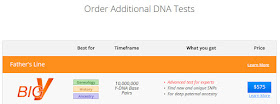 |
| Order Big Y |
Big Y Results
 |
| Big Y section |
I clicked immediately on Big Y matches. Would Cairns be there? I certainly hoped so, but I was stunned by what I saw.
 |
| Big Y Matching |
Cairns showed up as my closest match. There are many other matches not shown, but they are too distantly related to be relevant.
My brother and Mr. Cairns shared 23 newly-discovered SNPs! I expected to see a few, but not 23!
It took three screen shots to capture them. Here is screen 1:
Screen 2:
Because of the nature of the test and the way the results are reported, there are actually more than 23 shared SNPs and three "private" SNPs as reported by FTDNA. Family Tree DNA is conservative about what it considers to be a valid SNP. We can discover additional SNPs by using other analysis tools.
When the results are initially reported, your haplogroup assignment will be for a known SNP that is already on the haplotree.
 |
| Shared variants |
Screen 2:
 |
| More shared variants |
Screen 3:
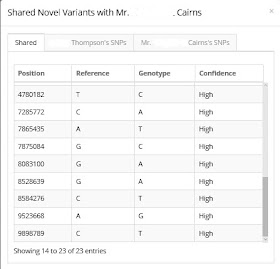 |
| Even more shared variants |
All of the SNPs shared with Cairns were previously considered to be among his "private" SNPs because they had not yet been seen in any other test results.
Now these 23 are shared and can be placed on the Y-DNA haplotree.
Here are the SNPs not shared with Cairns. These are currently Thompson "private" SNPs:
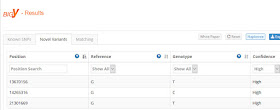 |
| Private variants |
When the results are initially reported, your haplogroup assignment will be for a known SNP that is already on the haplotree.
FTDNA reported our common haplogroup as R-A9871. This new assignment automatically changed in our FGC11134 project results.
What does all this mean? How closely are Cairns and I related?
| Haplogroup results |
Where can I find more information about my Big Y results?
What does all this mean? How closely are Cairns and I related?
After receiving the results I immediately began submitting them to multiple analysts. To share your results go to the Big Y results section and click Download Raw Data.
You will see options to access two different types of files. Some analysts want the VCF file, and some want the BAM file.
Full Genomes Corp (FGC) and YFull will analyze your results for a fee. They prefer the BAM file.
| Download raw data |
You will see options to access two different types of files. Some analysts want the VCF file, and some want the BAM file.
Full Genomes Corp (FGC) and YFull will analyze your results for a fee. They prefer the BAM file.
A link to the BAM file will not appear until you request it. The file is very large so you will rarely download it. Instead you will click "Share BAM" to receive a link to the file. You will copy that link and share it with FGC, YFull, or any other analyst who uses that file.
One analyst who does remarkable work for my haplogroup, at no charge, is Alex Williamson. His "Big Tree" is for Haplogroup R-P312 and the various downstream SNPs. He is beginning to incorporate other groups into his tree as well.
One analyst who does remarkable work for my haplogroup, at no charge, is Alex Williamson. His "Big Tree" is for Haplogroup R-P312 and the various downstream SNPs. He is beginning to incorporate other groups into his tree as well.
Alex wants the VCF file for his analysis. If you are within the R-P312 group, follow his instructions to submit the file.
The Thompson Big Y results have been submitted to FGC, YFull, Mike Walsh's L21 Tree, Iain McDonald's P312 Tree, Alex Williamson's Big Tree, and James Kane's Haplogroup R and Subclades Tree.
The Thompson Big Y results have been submitted to FGC, YFull, Mike Walsh's L21 Tree, Iain McDonald's P312 Tree, Alex Williamson's Big Tree, and James Kane's Haplogroup R and Subclades Tree.
We will take a look at Williamson's tree and Kane's tree in this post and examine these and the other analysts in more detail in future posts.
I clicked Download VCF to submit the file to my haplogroup projects and to Williamson's Big Tree. I shared the BAM file with FGC, YFull, and James Kane:
When my kit first appeared on Williamson's Big Tree it was immediately placed with Cairns who had been sitting on the tree in his own branch for more than a year. He now was forming a new group with Thompson.
I clicked Download VCF to submit the file to my haplogroup projects and to Williamson's Big Tree. I shared the BAM file with FGC, YFull, and James Kane:
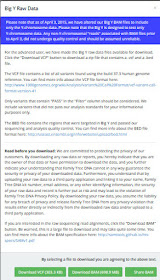 |
| Big Y data download links |
Alex Williamson's Big Tree
When my kit first appeared on Williamson's Big Tree it was immediately placed with Cairns who had been sitting on the tree in his own branch for more than a year. He now was forming a new group with Thompson.
Only shared SNPs are shown on the tree. "Private" SNPs will not appear until shared by someone else. My Thompson results were highlighted to indicate that they had not yet been fully analyzed.
At that time Williamson had close to 400 kits that had not yet been analyzed, so it took several weeks before my results changed the tree.
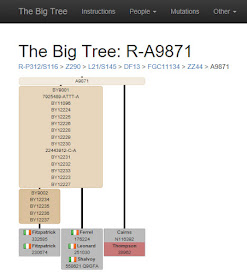 |
| New submission to Alex Williamson's Big Tree |
At that time Williamson had close to 400 kits that had not yet been analyzed, so it took several weeks before my results changed the tree.
In the meantime two other Big Y results had been submitted, and our R-A9871 section now looks like this:
In the above image, some SNPs have been given names like BY9001 and BY12552. Others had not yet been named, so they appear as their position on the Y chromosome followed by the ancestral value and the value held by the tester (the derived value).
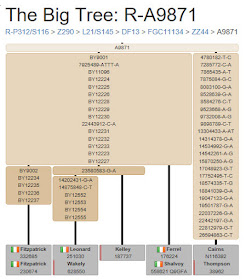 |
| Cairns and Thompson on Alex Williamson's Big Tree |
In the above image, some SNPs have been given names like BY9001 and BY12552. Others had not yet been named, so they appear as their position on the Y chromosome followed by the ancestral value and the value held by the tester (the derived value).
For example, all of the SNPs in the Cairns-Thompson block had not yet been named.
The number 4780182 in the first SNP tells its position on the Y chromosome. It is followed by the letters T-C. This means that the ancestors had a T in this position but in Cairns and Thompson the T has mutated to a C.
Notice how much one test can change the known Y-tree. In the first image Ferrel, Leonard, and Shalvoy were placed together.
Notice how much one test can change the known Y-tree. In the first image Ferrel, Leonard, and Shalvoy were placed together.
But Kelley shared one of the SNPs that had formerly been one of Leonard's "private" SNPs. Wakely shared seven SNPs with Leonard, including the one shared by Kelley. Because Kelley does not have the additional six SNPs, this means that the 23580583-G-A SNP occurred before the others. Leonard and Wakely are now forming a separate branch.
What about that Thomson who was placed with the Edgecombes in the FGC11134 project? [Review the first image in this blog post.] Should he have been placed with the Thompsons?
What about that Thomson who was placed with the Edgecombes in the FGC11134 project? [Review the first image in this blog post.] Should he have been placed with the Thompsons?
If we extend this tree we can see in the image below that Thomson and one of the Edgecombes took the Big Y test and appear in the Big Tree.
The FGC11134 project administrators were correct. Thomson is very distantly related to the Thompsons. They are in completely different haplogroups.
As mentioned before, new SNPs are not automatically named. This is a manual process that generally occurs about a week after you initially receive your results.
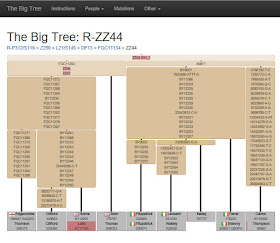 |
| Thomson and Thompson in The Big Tree |
Family Tree DNA assigns new haplogroup
As mentioned before, new SNPs are not automatically named. This is a manual process that generally occurs about a week after you initially receive your results.
All of the SNPs shared by Thompson and Cairns are now named by Family Tree DNA, and we form a new haplogroup under A9871. The haplogroup is named by the first SNP in the block, but all 23 are listed.
When someone comes along who shares at least one of those SNPs, but not all of them, the Thompson-Cairns haplogroup will change.
Below is our contribution to the Y-DNA haplotree:
The new haplogroup is now shown in the FGC11134 Project:
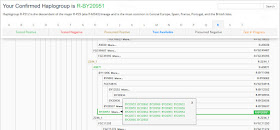 |
| Family Tree DNA haplotree |
The new haplogroup is now shown in the FGC11134 Project:
| New haplogroup display |
We have a new haplogroup and share more than 23 new SNPs.
What does that tell us?
James Kane analyzes BAM files to compile a tree for Haplogroup R. Using an increasing number of SNP tests, he is also attempting to date the haplogroups.
As we saw in my previous blog post, Y-DNA STRs, SNPs, and haplogroups, FTDNA estimated our initial projected haplogroup, R-M269, at an age of 25,000 years.
SNP pack testing took us forward in time to SNP FGC11134. Kane estimates this SNP at an age of 1350 BC. That's much better than 25,000 years, but it's still not helpful for finding more about Robert Thompson's family.
The Big Y moved us to haplogroup R-A9871 which Kane dates at approximately 1050 BC. But with more than 23 SNPs down from R-A9871, Kane is estimating the time to the most recent common ancestor (TMRCA) of Cairns and Thompson at about 1450AD! That is around the time of the adoption of surnames.
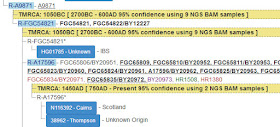 |
| Time to Most Recent Common Ancestor (TMRCA) |
Surnames became necessary when governments introduced personal taxation. At some point two descendants of the common Cairns-Thompson ancestor came to be known by different surnames.
One of them probably lived near a rock boundary. The surname Cairns is Scottish and first appears in Scottish records around the mid-fourteenth century. Cairns means a pile of stones raised as a boundary or memorial. Perhaps an ancestor named James was known as the one who lived near the boundary: James Cairns.
Another descendant was the son of a man named Thomas. He might have been known as John, son of Thomas, or John Thompson.
We don't yet know exactly when or where our lines connect, but we do know that Cairns traces his ancestry to a specific parish in Scotland.
Perhaps more DNA matches will help both of us extend our family lines.
We've come a very long way, but we've almost gone as far as we can go until someone else shares any of our SNPs.
Can I make my Big Y results genealogically relevant?
I am at the point of bringing my haplogroup into the genealogical time period. So I wrote to all the Thompsons on my list of matches. This was in August of this year, and Family Tree DNA had the Big Y test on sale at the lowest price ever.
I told the Thompsons that I had taken the Big Y and what it revealed about our relationship to Cairns. I told them that we needed another Thompson to take the Big Y so that we could form our own Thompson-specific haplogroup and begin to assign SNPs to the descendants of Robert Thompson.
I was most interested in having my most distantly-related Thompson do the Big Y, and I named the descendant of Augustus M Thompson in the email.
Why did I want to have my most distantly-related Thompson take the Big Y test? Because I want to share some SNPs with him, but not all. I want to assign specific SNPs to the descendants of Robert Thompson. If I tested my other brother, for example, I would learn nothing new.
That same day, the descendant of Augustus Thompson wrote to me and said he had ordered the Big Y. Wow! In Alex Williamson's Big Tree, the image below will change.
 |
| The Big Tree before the results of the second Thompson test |
Similar to what you see with the two Fitzpatricks, two Thompsons will break off and form a separate branch below Cairns. We will have our own haplogroup assignment.
We know the common ancestor of Augustus Thompson and Electious Thompson. I was able to extend both of these lines using the results of Y-chromosome STR testing.
Augustus Thompson is the son of Bennett Thompson. Here is Bennett's tree:
 |
| Family Tree of descendant of Augustus Thompson |
I descend from Electious Thompson, son of Electious born in 1750. Here is his tree:
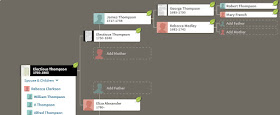 |
| Family Tree of descendant of Electious Thompson |
So the most fascinating part is this. Since the two Thompsons share a known common ancestor, George Thompson, any SNPs that are shared between the two Thompsons, and not by Cairns, occurred somewhere between George Thompson and the common Cairns-Thompson ancestor.
How closely related we are to Cairns will be determined by how many SNPs are shared between the two Thompsons.
Any SNPs that are not shared can be assigned to the lines of James Thompson or Robert Thompson (sons of George).
We might determine exactly in which generation each SNP occurred by testing more Thompson descendants.
This new Big Y test will form the framework that will eventually combine SNPs, STRs, and genealogical research to produce a fully documented Thompson family tree.
With our SNP connection to the Y-DNA haplotree we will be able to see our exact connection from the present all the way back in time!
We have begun a long process that just became longer because Family Tree DNA recently announced that it is making major changes to the Big Y test. These changes will be fabulous in the long run, but will cause some short-term agony.
The changes will impact all of the databases we use for analysis including Alex Williamson's Big Tree, YFull.com, and others.
I've been researching this Thompson line since the 1970s and did the first DNA test on my brother in 2005. I guess I can wait a little longer to have the results show on all sites.
In the meantime we will examine some of the other analysis tools to see what else they can reveal about our Big Y test.
For example, did you know that the Big Y test not only reveals new SNPs but can contain more than 500 STRs?
We will also examine other tests such as mitochondrial DNA and autosomal DNA before we can finally show the new Thompson tree in its full glory.
It's going to be a great year coming up as we watch all the changes and make new discoveries.
Testing strategy to get the most from Big Y DNA
- Test yourself first. Don't wait until someone else has tested. When Cairns ordered the Big Y, no other Cairns had tested. But he took the test anyway because he wanted to find out what he could learn about his ancestry. I am forever grateful that he did! When he received his results he had no Big Y matches who were even remotely related. So he publicized his results and waited. Now he shares a long string of SNPs with my brother. I might not have done the test at all if I had not been curious about my relationship to Cairns. If everybody waits until they are assured they will get a match we'll all be waiting forever. Be a leader!
- Recruit others. You can wait until someone else shows up as a Big Y match, or you can recruit people. It was only after I took the Big Y test that another Thompson was willing to do so. But I had to notify the Thompsons of my results and explain how the test could help us with our ancestry. My list of Y-STR matches includes some people who do not share the Thompson surname. I need to encourage them as well.
- Publicize your results. In addition to recruiting people, you can help motivate people you don't even know to do DNA testing. Let others find your results by joining surname, haplogroup, and geographical projects. For example I have joined the Thompson surname project, the Maryland geographical project, and the R1b, P312, L21, and FGC11134 haplogroup projects as well as several others. You can learn more about surname projects in Surname projects: Examining my first Y-DNA match. You can learn more about haplogroup projects in Y-DNA STRs, SNPs, and haplogroups. I have also submitted Big Y results to Full Genomes Corp, YFull, and the other trees I mentioned earlier in this blog entry.
- Build an extensive online family tree. Trace up and down family lines to help others connect with you. One of the best sites for this is Ancestry.com because it has the most subscribers, but I use multiple sites because I want to have my ancestry in as many places as possible. See my 2014 blog post about Online Family Trees. If you have a tree at Ancestry.com you can easily transfer it to Family Tree DNA. See the section "Exporting a tree from Ancestry.com" in Setting up for great DNA matches. Be sure your family tree is public! By tracing descendants of your ancestors you will help other people who have not gotten back as far as you have. I am regularly contacted by people who see their grandparents and great-grandparents in my tree. I often look to see if these people would be good candidates for DNA testing to help break through another brick wall. For Y-DNA testing alone, I have recruited people for not only my Thompson line but many other lines as well. Y-DNA can help you find ancestors in a way that no other test can.
- Be sure that all of your account settings are set correctly so that you can make maximum use of your DNA results. See Setting up for great DNA matches.
- Take screen shots of your DNA results and post them to your online family tree(s). I took screen shots of my YSearch records, for example, and posted them to every relevant ancestor in my online trees. [2020 update: The YSearch database no longer exists, so I'm especially glad that I had taken those screenshots!] You can see an example of this in the "Finding Family Members for DNA Testing" section of Setting up for great DNA matches. I have received emails from people wondering about Y-DNA testing and how they can do it.
- Take other DNA tests to expand your pool of family matches. Upgrade your Y-STR markers to a higher level. Order an autosomal DNA test from Ancestry DNA, Family Tree DNA, 23andMe, or My Heritage. Prove your ancestry by using as many resources as possible. You are leaving a lasting legacy for future generations.
Up next: We submitted our results to YFull.com. See What are the Benefits of YFull?
See the new changes to Big Y results and what they can reveal: Evaluating new Big Y changes
And the best part: What did the Thompson Big Y reveal? See The Big Y could be the best DNA test ever!
______________________________________________________
Disclosure
Links to Family Tree DNA appear in the sidebar. I receive a small contribution if you make a purchase, but clicking through the link does not affect the price you pay.
What a great read! Thanks so much for the excellent summary of how to get there and what to expect
ReplyDeleteIan Fitzpatrick
I'm very glad you wrote this blog. I find it difficult to articulate the importance of testing BigY to various people, especially some in my somewhat well tested surname project (Doherty). Your blog helps clarify the potential power of this test and I'm thrilled to share the link with others.
ReplyDeleteAll of us have been at the point where we didn't see much value in SNP testing. After all, SNP testing has traditionally been about your deep ancestry. While anthropological ties may be interesting, it is not the primary focus of genealogists. We want something that can help us within the past few hundred years, not several thousand years! Finally we have a test that can do that. The Big Y has the potential to take us from the present all the way back in time and reveal relationships in a very precise manner. I didn't fully realize its power until I ordered the test myself. STRs and SNPs form a complementary system. When we've gone as far back in time as we can with STR testing, we need to take the Big Y to work forward in time to the point where we find the connection. It is because of thousands of pioneering men who have already taken the Big Y that this is possible. Thank you to all you men who have taken the Big Y. If you're still thinking about it, take the plunge!
ReplyDeleteI've just come across your blog and the series of posts on Y-DNA testing. The series provides a great education for genealogists learning the value of Y testing. You've done a great job of demystifying the process and tests, and highlighted what the tests can tell us. Thanks, Linda!
ReplyDeleteI really enjoyed your article, enough that I recommended it to others on the WikiTree forums (https://www.wikitree.com/g2g/482929/great-blog-article-about-the-big-test-and-what-it-can-do-for-you). I know that many there will enjoy it too.
ReplyDeleteI'm in a similar boat as you, with the 'terminal' SNP S23346 (R-M269>U106>Z17>S23346). It has few testers yet, and is rather old, rather high in the current table, which means there must be numerous branches below it. My own paternal ancestor is Norwegian (https://www.wikitree.com/wiki/Jakobsen-407), and I recently discovered some Henderson's from Scotland, and a Dutch man with the same ending SNP, not a common surname among us. I find that rather exciting, lots of discoveries to be made, branches to figure out! If we all take the Big-Y, hopefully we will make some progress, maybe even find common ancestors in more recent times.
Rob, Thank you for that. You reminded me about WikiTree, and now I'm busy entering dozens of my kits into the system.
ReplyDeleteI love DNA tests!
Your article has convinced me to take the BigY Test just as soon as it next goes on sale.
ReplyDelete